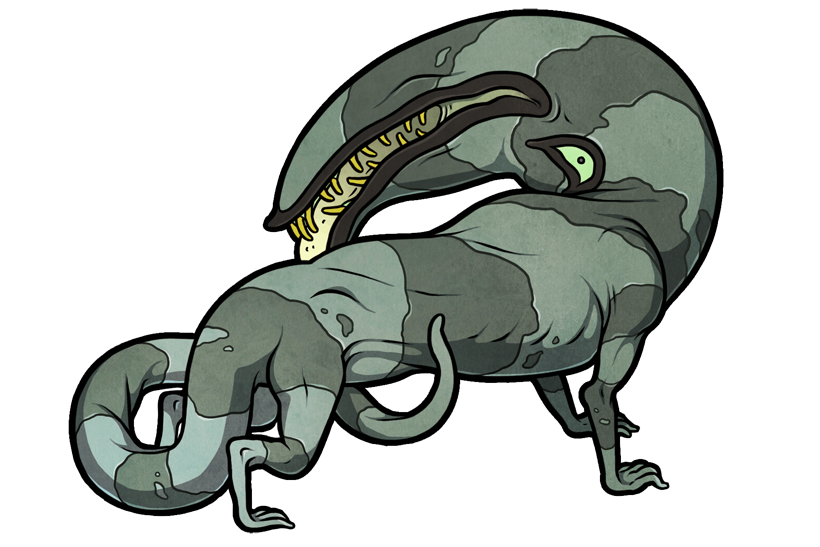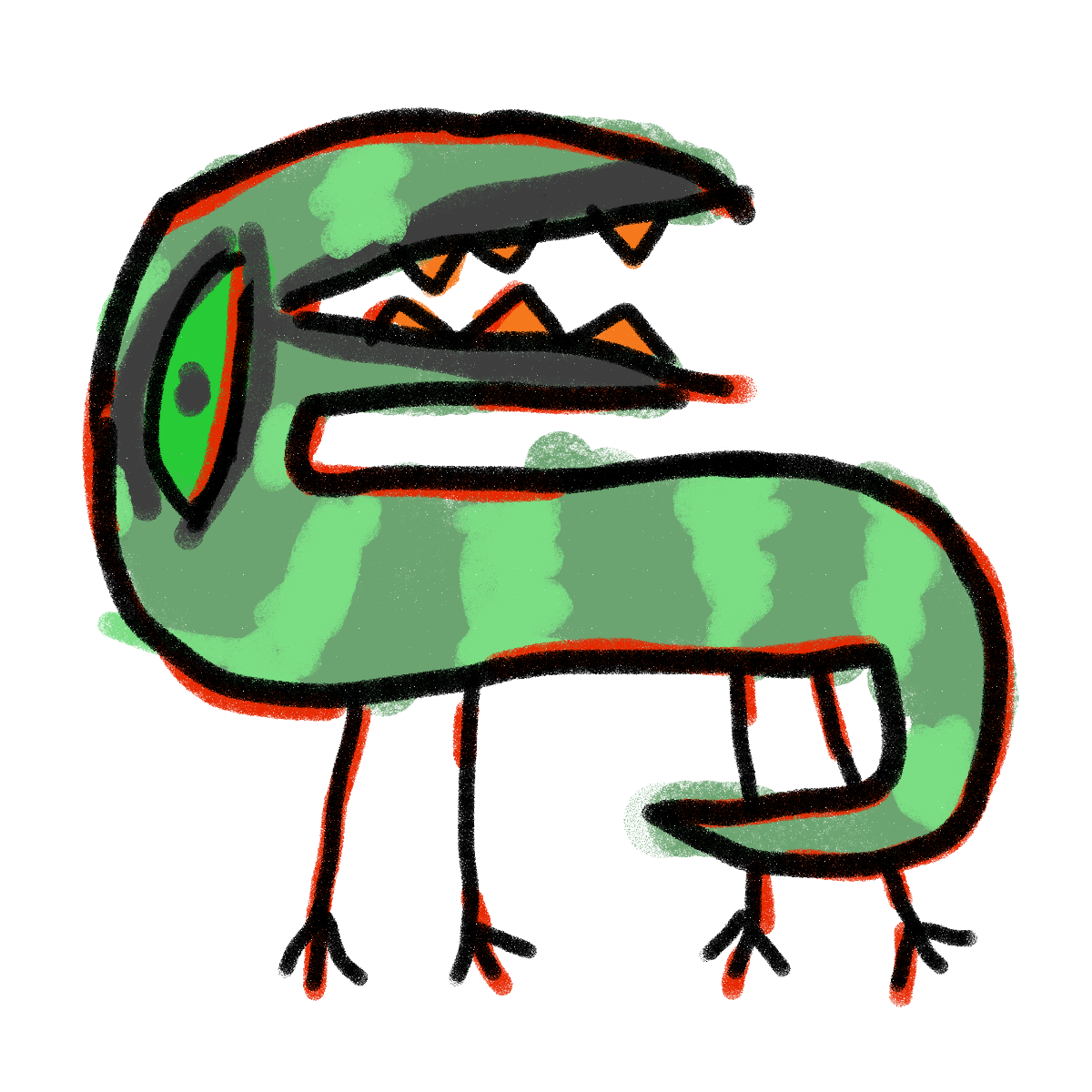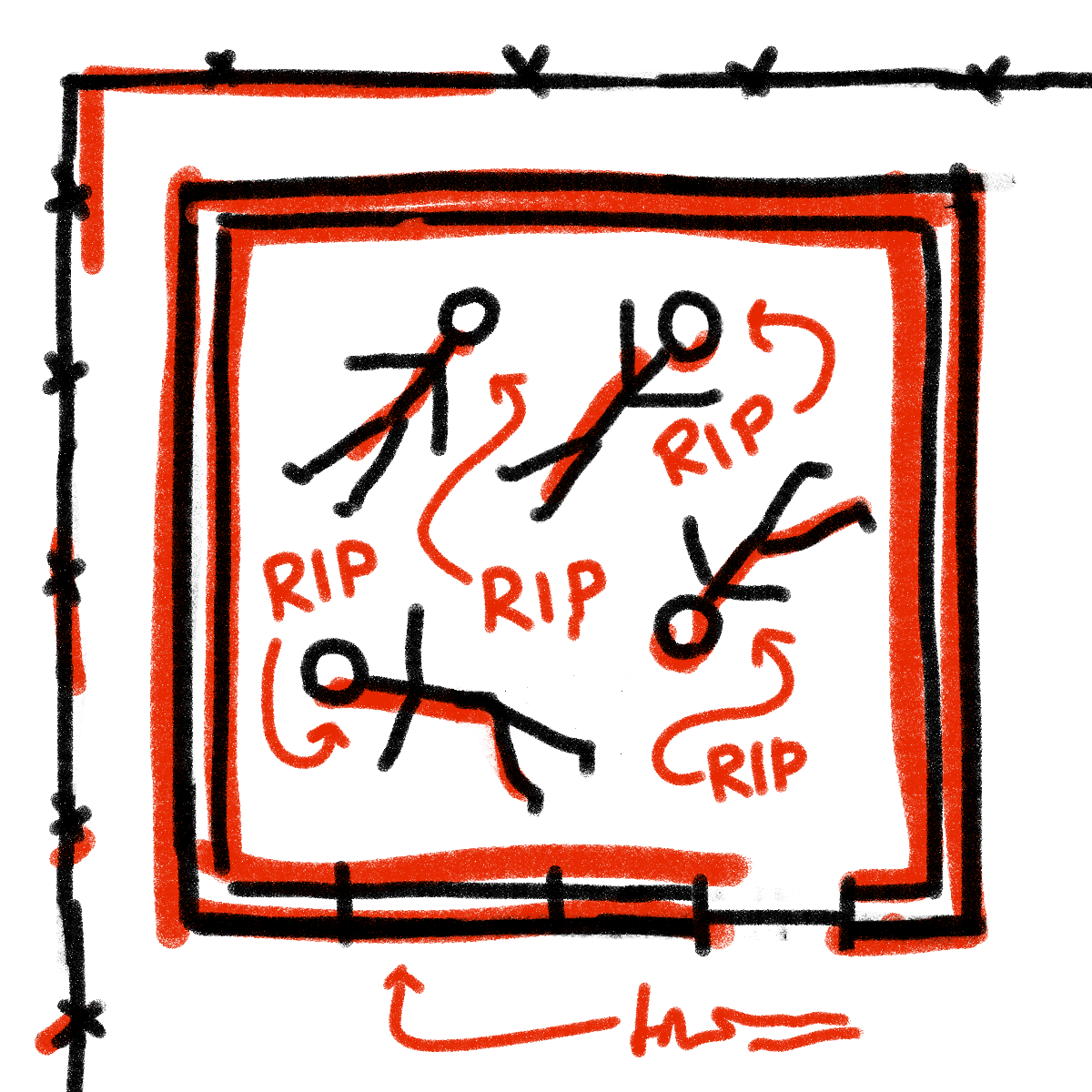

Gangridrene
the Gourmands
prefix gangri suffix drene
physical appearance
The gangridrene /ˈɡæŋɡrədriːn/ is a pale green stranger with thin, spindly legs and an engorged and lolling head. Its skin is clammy and slimy to the touch, and its silvery inner flesh is soft enough to pull apart with only mild effort. The gangridrene's mouth is four to five feet deep, and does not connect with its body cavity, inside of which, its thick intestines float in a viscous, colorless fluid. Its many long, sharp teeth are brittleჶ despite their fearsome appearance; due to this breakage, the gangridrene grows new teeth continuously over the course of its life, causing most individuals to possess a jagged and many-rowed smile. The gangridrene drips saliva from its mouth in slight but continuous strands. It possesses no regenerative ability, and even firm pressing can be enough to cause its body to bruise.
ჶ You might break them by accident...reaching into its sweaty mouth.
varying shades of pigmentation
1. pallimur /
2. gengentovi /
3. hox /
4. rigordane /
5. fessicon /
6. algoric
The stranger's voice is quiet and whispery, and predominantly baritone, with higher-pitched individuals accounting for only 23% of gangridrene. Usually eschewing outright speech, the gangridrene instead hums to itself in aimless, somber tunes.
Glar, gl. Rrrmmmm. Rr, gll?

environment and generation
The gangridrene appears anywhere that human corpses or parts of corpses are found. Graveyards and morgues are the most common loci, but even museums or medical research facilities can house a gangridrene infestation. It appears with less frequency in hot climates, and the gangridrene that do appear in these regions usually possess slightly more saturated colors and a markedly brownish tint.
The gangridrene first appears as a pile of dirt and grime, which shifts and clumps together until the stranger's body is formed. Five percent of the time, individuals only successfully generate 80-90% of their body – these incomplete gangridrene often have open wounds through which their guts spill slightly forth, and usually possess lower stability and lead shorter lives than individuals which have formed fully, but display no significant differencesႱ in behaviour.
Ⴑ That's what happens, when you're already rotten.



generative habitat notes
generation induced 26/09/20 in Mollywood Cemetery
notable factors
1. four dead bodies, RIP suckers!!
2. climate controlled room, windows boarded up
3. lower than average temperatures (needed to wear winter jacket)
4. barbed wire fence
5. stains and organic debris across 62% of floor
notes
it generated an "incomplete" body - first time seeing one in person!
another once-in-a-lifetime offer

"that's down there, rotting in the ground?"

it's true – you might have dozens of human and animal bodies, each one filled with tallow, bone protein, other sources of fuel – it's called bio-rendering, and your soil could be instantly drained of all those valuable products and nutrients ...
wait, I didn't mean it like ... that!™
 not again..?? you promised your loved ones a funeral, and now you're in debt ... find out, body disposal, your medical waste for science, your loved one could be a hollywood stunt body in a "looks real" production! ¤´C ²] ´C F ³o Ó ¥H ²] ... and go DEBT FREE-TODAY
not again..?? you promised your loved ones a funeral, and now you're in debt ... find out, body disposal, your medical waste for science, your loved one could be a hollywood stunt body in a "looks real" production! ¤´C ²] ´C F ³o Ó ¥H ²] ... and go DEBT FREE-TODAY
behaviour and effects
The gangridrene possesses a sluggish but determined disposition. Its sole motivation is to seek out corpses within its environment, and trudges towards them in a torpid, plodding shamble. The stranger's muculent hands and feet make wet slurping sounds with each step, and it leaves a layer of slime behind on everything it touches. Although the gangridrene lacks outright strength, it displays considerable persistence, and spends days pulling clumps of earth aside in order to exhume buried bodies, or pounding at morgue drawers for weeks straight.
Once it does obtain a dead body, it crams it into its mouth with clumsy desperation, twisting and crunching the legs and arms to ensure a tight fit.ɗ In addition to this hunger towards corpses, the gangridrene's presence also causes flesh to decay at an accelerated rate. As such, bodies held in the mouth rot completely within three to seven days. In the final stage, they jellify into the same clear slime secreted by the stranger; they are no longer distinguishable as human beings.
ɗ Because it's throat doesn't connect...remember?
When there are no corpses nearby, the gangridrene wanders with no goal. Although it displays little interest in anything besides dead bodies, it does approach mannequins, statues, or other objects which possess a human form. While it does not devourȢ them, it will slurp and slobber at their limbs and bodies, just as a small infant or dog might mouthʓ a favorite toy.
The gangridrene does not gravitate towards animal corpses.ɧ
ɧ It walks past the pile of rat corpses, and – timelapse videos sped up, an explosion of fur and scattered bones.
interactions between gangridrene
The gangridrene is non-grouping, but does approach others of its strain that it encounters on its travels. When two gangridrene meet, the older tends to place its hand upon the forehead of the younger, an action which leaves behind a black handprint that fades away within several seconds. Individuals sometimes lick each other's heads, as well, the wet slopping sounds filling the air around them.
Unlike many other predatory strangers, the gangridrene is rather amicable, and does not fight over corpses. Instead, the larger of the two tends to claim the corpse, with the smaller nodding and continuing on its own way.
interactions with sensitives
Although the gangridrene's flesh-rotting effect is most pronounced in corpses, it does affect living sensitives, as well. Sensitives first notice this effect around cuts or abrasions, which grow dark and mottled before the flesh decays outright. Even wound-free sensitives, however, experience a dark patchwork effect on their skin, which spreads and grows necrotic as exposure continues. It takes approximately twelve minutes for an otherwise healthy sensitive to develop dangerous injuries in the gangridrene's presence, and forty minutes for these wounds to spread to a fatal degree.
Just as it seeks out and consumes corpses, the gangridrene also approaches and attempts to devour any living sensitive it finds. It does not appear able to make any distinction between a person and a dead body. Although the stranger is larger than any human being, it is not significantly robust.
what they're saying is true

 don't let the morgues fill up!
don't let the morgues fill up!
demand is growing and the numbers don't lie – but there's a new solution, & it's called, "legal waxification"! the entire body can be sanitized and stored in our underground warehouses, ready to be used for future products, where they're "not alive"..!
here, you're safe to be yourself
you can't throw it all away forever
what if none of it mattered?

ჺ
꒻
꒻
Once it captures a sensitive, it places them inside its mouth. Although this, in and of itself, is not immediately fatal, sensitives who find themselves unable to escape decay alive over the span of several hours. Ultimately, however, this proves fatal for the gangridrene, as well, as the corpses of devoured sensitives are converted not to clear gelatin, but to a thick, corrosive black fluid. This "corrodorzian ooze" causes severe injuries (and often death) to the stranger, eating through the flesh in a bubbling, crinkling ripple. The affected gangridrene cries to itself in plaintive echoes, butɬ aside from this dramatic behaviour, it continues to engage in its usual actions until its face softens and sloughs off.
ɬ Serves you right, I thought.
The dead stranger collapses into a heap, and abruptly dissolves.Ъ
Ъ But, it doesn't do this at any other time. It doesn't die like this, otherwise.
aging and death
An aging gangridrene's skin grows softer, its body becomes misshapen, and its flesh becomes riddled with wounds and sores. Its behaviour remains unchanged, but diminishes in strength and focus day-by-day, until it slows down and stops, like a toy running out of batteries. The corpse falls apart and decays into mushy grey chunks, which if left undisturbed, decrease in size over five to five hundred days, until they disappear. Although the presence of other gangridrene speeds up their decomposition, nearby individuals do not recognize the dead stranger as a corpse.

